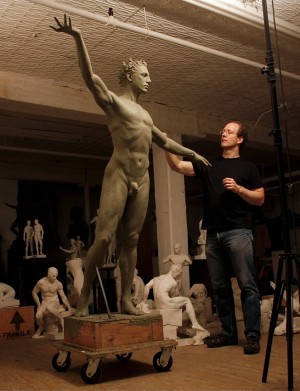Living the Renaissance Life, Part Two: A Conversation with Sabin Howard
GALO: You spent a lot of time in Europe since your mother was from Torino, Italy. What kind of effect did your time spent there have on you and your development as an artist? Were you entranced by the Renaissance art vastly present there still to this day?
SH: I was in Italy from [the] age [of] three months to three years, so that laid the foundation for me in understanding how visual beauty and proportion affect us internally. Standing in the piazzas and living in homes with beautifully proportioned rooms with marble floors and huge entryways left an imprint on me, terms of what makes us feel elevated.
GALO: Besides the Aphrodite piece that you had reworked several times before deeming it perfect, do you have a favorite piece that you have sculpted over the years?
SH: I am most happy with the Apollo. It’s really the first time the sculpture matches my philosophy about life. It’s also the beginning of a new phase in my art in which grace and power are very present because of the finish and completion of the sculpture [in] matching my initial vision.
GALO: Can you walk us through the process of making a sculpture from start to finish and what you do in the meantime?
SH: The answer to this question is several chapters long, and I recommend the “Process Makes Perfect” chapter in our book, The Art of Life.
GALO: As I previously mentioned to your wife, Elton John requested a few pieces from the novel. Can you reveal which pieces most appealed to him and the average cost? Were you at all surprised at his interest?
SH: I am pleased that he asked for a price list. This is still in process, so I don’t want to get too specific about it.
GALO: While we are on the subject, how much do your pieces normally sell for?
SH: My small pieces start at $10,000. The life-size pieces are in the six figure range.
GALO: In large part, your education of art came from books. You read vigorously about artists such as Vasari and Michelangelo amongst others, learning about them and their techniques. Do you feel that through such curiosity, your own techniques developed and possibly merged with those of the Renaissance age?
SH: My art education came from life more than from books. It came from professors who gave me an amazing set of tools, terms of how to break down the body. It came from living in Italy and going to museums and piazzas and seeing the architecture and the light on the buildings. My aesthetic choices were established early on by seeing the proportions inherent in classical architecture. Torino is extremely structured, orderly, and organized as a city, which influenced me.
GALO: Going back to your fascination with books and with your wife being a writer, do you find it of importance to educate the youth of America about the arts through books, whilst at the same time solidifying and encouraging them to read (as statistics show that less and less people reach for books on a yearly basis)? What do you think could be done to encourage the younger generations to not only reach out for books but to reach out to the arts and art education in general? Does it all go back to the parents?
SH: Beautiful art is made through the act of actually using the visual part of your brain. Younger generations have to understand that they work within a framework; they are not just making individual gobbledy-gook, but something that is more universally understood. They must be taught that art is a process of visual translation, and yes, it helps if their parents drag them to museums. They need to understand that they don’t have to reinvent the wheel. The past doesn’t have to be rejected in order to prove oneself creative. The past is something to build from.
GALO: You yourself taught courses at the undergraduate and graduate level for over 20 years. What did you do to help those who had the talent and passion for art to further develop as artists? Do you still teach from time to time?
SH: I gave them a system to go into the studio and deduce information from the life models which could be put into a systematic art form. How do you translate life models into art? You do it using a system of perception and empirical knowledge. I have a few private students. Also, I tried to impress on my students that, like athletes, they needed to train all the time. Their visual skills must be exercised and used all the time so the level of focus can be held for longer and longer periods of time.
GALO: You’ve shown your artwork at over 50 solo and group show and exhibited at various galleries and museums, inclusive of your recent exhibit at the Classical Architecture and Art building in New York. Yet, despite this prestigious resume of exhibits, there must be one you have dreamed of but haven’t yet had the chance to put your stamp on. Care to indulge us one last time with one of your secrets?
SH: My next project involves doing a multi-figure composition where the two figures are entwined. Again, this is a suggestion from my wife, who told me I was a one-trick pony who could only do solo figures who were solipsistic like me. So, I decided, after some kicking and screaming, to do as Traci suggested and make figures that are relational.


